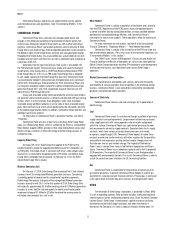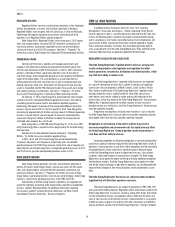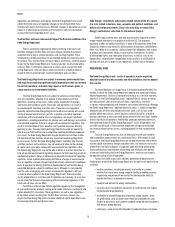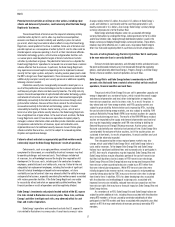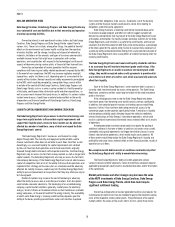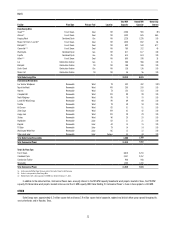Duke Energy 2013 Annual Report Download - page 32
Download and view the complete annual report
Please find page 32 of the 2013 Duke Energy annual report below. You can navigate through the pages in the report by either clicking on the pages listed below, or by using the keyword search tool below to find specific information within the annual report.
PART I
14
REGULATED UTILITIES
Regulated Utilities transmits and distributes electricity in Ohio. Regulated
Utilities also generates, transmits and distributes electricity in Kentucky.
Regulated Utilities also transports and sells natural gas in Ohio and Kentucky.
Duke Energy Ohio applies regulatory accounting to substantially all of the
operations in its Regulated Utilities operating segment.
Duke Energy Ohio’s Regulated Utilities service area covers 3,000 square
miles and supplies electric service to 830,000 residential, commercial and
industrial customers and provides regulated transmission and distribution
services for natural gas to 500,000 customers. See Item 2, “Properties” for
further discussion of Duke Energy Ohio’s Regulated Utilities generating facilities.
COMMERCIAL POWER
Commercial Power owns, operates and manages power plants and
engages in the wholesale marketing and procurement of electric power, fuel
and emission allowances related to these plants, as well as other contractual
positions. Commercial Power’s generation operations consist primarily of
coal-fired and gas-fired nonregulated generation assets located in the Midwest
region of the United States. The asset portfolio has a diversified fuel mix
with baseload and mid-merit coal-fired units as well as combined cycle and
peaking natural gas-fired units. Generation from the coal-fired and gas-fired
assets is dispatched into the PJM wholesale market. These assets earn energy
and capacity revenue at market prices. See Item 2, “Properties”, for further
discussion of Duke Energy Ohio’s Commercial Power generating facilities.
On February 17, 2014, Duke Energy Ohio announced that it had initiated
a process to exit its nonregulated Midwest generation business. Considering
a marketing period of several months and potential regulatory approvals,
Duke Energy Ohio expects to dispose of the nonregulated Midwest generation
business by early to mid-2015. In the first quarter of 2014, Duke Energy Ohio
will reclassify approximately $3.5 billion carrying value of its Midwest generation
business to assets held for sale and expects to record an estimated pretax
impairment charge of $1 billion to $2 billion to reduce the carrying value to
estimated sales proceeds less cost to sell.
Duke Energy Ohio is a PJM FRR entity through May 31, 2015. As an FRR
entity, Duke Energy Ohio is required to self-supply capacity for the Duke Energy
Ohio load zone.
See Note 4 to the Consolidated Financial Statements, “Regulatory
Matters,” for further discussion related to regulatory filings.
In 2013, 2012, and 2011 Duke Energy Ohio earned approximately
37 percent, 36 percent, and 24 percent, respectively, of its consolidated
operating revenues from PJM. These revenues relate to the sale of capacity and
electricity from all of Duke Energy Ohio’s nonregulated generation assets in 2013
and 2012 and its gas-fired nonregulated generation assets in 2011.
DUKE ENERGY INDIANA
Duke Energy Indiana generates, transmits and distributes electricity in
portions of Indiana. Duke Energy Indiana’s service area covers 23,000 square
miles and supplies electric service to 800,000 residential, commercial and
industrial customers. See Item 2, “Properties” for further discussion of Duke
Energy Indiana’s generating facilities, transmission and distribution. Duke Energy
Indiana is subject to the regulatory provisions of the IURC and FERC.
Substantially all of Duke Energy Indiana’s operations are regulated and
qualify for regulatory accounting. Duke Energy Indiana operates one reportable
business segment, Regulated Utility. For additional information regarding
this business segment, including financial information, see Note 3 to the
Consolidated Financial Statements, “Business Segments.”
ITEM 1A. RISK FACTORS
In addition to other disclosures within this Form 10-K, including
Management’s Discussion and Analysis – Matters Impacting Future Results
for each registrant in Item 7, and other documents filed with the SEC from time
to time, the following factors should be considered in evaluating Duke Energy
and its subsidiaries. Such factors could affect actual results of operations and
cause results to differ substantially from those currently expected or sought.
Unless otherwise indicated, risk factors discussed below generally relate to
risks associated with all of the Duke Energy Registrants. Risks identified at the
Subsidiary Registrant level are generally applicable to Duke Energy.
REGULATORY, LEGISLATIVE AND LEGAL RISKS
The Duke Energy Registrants’ regulated electric revenues, earnings and
results are dependent on state legislation and regulation that affect
electric generation, transmission, distribution and related activities, which
may limit their ability to recover costs.
The Duke Energy Registrants’ regulated utility businesses are regulated
on a cost-of-service/rate-of-return basis subject to statutes and regulatory
commission rules and procedures of North Carolina, South Carolina, Florida,
Ohio, Indiana and Kentucky. If the Duke Energy Registrants’ regulated utility
earnings exceed the returns established by the state utility commissions,
retail electric rates may be subject to review and possible reduction by the
commissions, which may decrease the Duke Energy Registrants’ future earnings.
Additionally, if regulatory bodies do not allow recovery of costs incurred in
providing service on a timely basis, the Duke Energy Registrants’ future earnings
could be negatively impacted.
If legislative and regulatory structures were to evolve in such a way that
the Duke Energy Registrants’ exclusive rights to serve their regulated customers
were eroded, their future earnings could be negatively impacted.
Deregulation or restructuring in the electric industry may result in
increased competition and unrecovered costs that could adversely affect
the Duke Energy Registrants’ financial position, results of operations or
cash flows and their utility businesses.
Increased competition resulting from deregulation or restructuring legislation
could have a significant adverse impact on the Duke Energy Registrants’ results of
operations, financial position, or cash flows. Retail competition and the unbundling
of regulated electric service could have a significant adverse financial impact
on the Duke Energy Registrants due to an impairment of assets, a loss of retail
customers, lower profit margins or increased costs of capital. The Duke Energy
Registrants cannot predict the extent and timing of entry by additional competitors
into the electric markets. The Duke Energy Registrants cannot predict if or when
they will be subject to changes in legislation or regulation, nor can they predict the
impact of these changes on their financial position, results of operations or cash
flows.
The Duke Energy Registrants’ businesses are subject to extensive federal
regulation that will affect their operations and costs.
The Duke Energy Registrants are subject to regulation by FERC, NRC, EPA
and various other federal agencies. Regulation affects almost every aspect of the
Duke Energy Registrants’ businesses, including, among other things, their ability
to: take fundamental business management actions; determine the terms and
rates of transmission and distribution services; make acquisitions; issue equity
or debt securities; engage in transactions with other subsidiaries and affiliates;
and pay dividends upstream to the Duke Energy Registrants. Changes to federal









